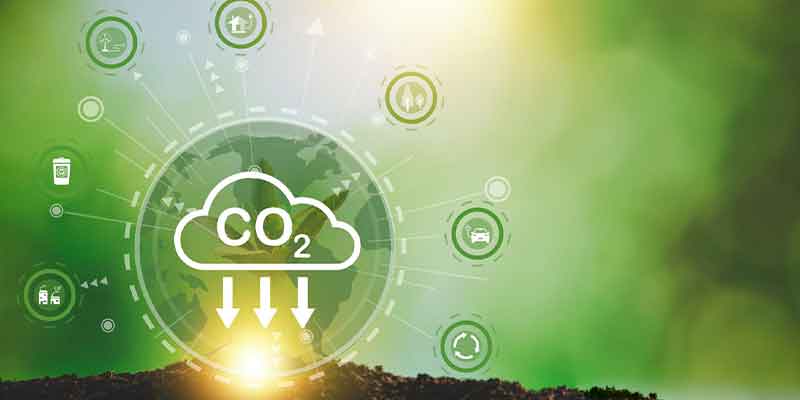One method to combat climate change is carbon sequestration, which involves extracting and storing carbon from the atmosphere.
It will take a massive effort from everyone on Earth to further stop the atmosphere from warming. Every viable answer, from reducing our reliance on carbon-emitting fuels to setting a net zero emissions target by 2050, is critical to avert unprecedented climate change.
Humanity is making a concerted effort to remove carbon from our atmosphere by changing the ways we build, consume, travel, and generate power. This effort goes hand in hand with a transition to clean energy systems and the decarbonization of high-emission practices, such as construction and transportation. However, strategies like carbon sequestration demonstrate how humans may cooperate with nature to address the climate challenge.
What’s the process of carbon sequestration?
Carbon dioxide (CO2) from the Earth’s atmosphere is captured, removed, and stored through carbon sequestration. It is a crucial technique for eliminating carbon from the world’s atmosphere.
This is crucial because around 45% of the CO2 humans produce still present in the atmosphere and contributes significantly to global warming. By storing carbon, more emissions contributing to global warming can be avoided.
There are two main ways that carbon can be buried: biologically or geologically. Additionally, even though it is promoted intentionally through various biological and geological techniques, it also naturally occurs on a massive scale in the environment.
The definition of biological carbon sequestration
The process of biological carbon sequestration involves the storage of carbon in the environment. ‘Carbon sinks,’ such as forests, grasslands, soil, seas, and other water bodies, are included in this. This type of sequestration is often referred to as “indirect” or “passive.”
Woodlands and forests are considered one of the greatest natural carbon sequestration methods. During photosynthesis, CO2 binds to plants and is released as a purifying emission in exchange for oxygen.
While an estimated 25% of the world’s carbon emissions are stored along with forests in other vegetative forms, such as grasslands or rangelands, forests typically store twice as much carbon as they release (fields, prairies, shrublands, etc.).
For carbon sinks to absorb CO2 properly, these natural ecosystems must be protected. The main threat to this natural process is deforestation, followed by intensive agriculture and development.
Soil
Carbon may be trapped and stored as carbonates in bogs, peat, and swamps. As CO2 combines with other mineral components like calcium or magnesium over thousands of years, these carbonates accumulate. Carbon is eventually liberated from the ground, but it doesn’t happen immediately—in extreme situations, it takes more than 70,000 years.
Oceans
Large bodies of water and aquatic ecosystems are also excellent CO2 absorbers. Another 25% of the CO2 released into the atmosphere by the planet is reportedly absorbed by them. Most of this carbon is stored in the ocean’s uppermost layers. Another reason to decarbonize our atmosphere is that too much can acidify the ocean, endangering the biodiversity that dwells below.

Geological carbon sequestration: What is it?
It is called geological carbon sequestration, when carbon is held in materials like subsurface geological formations or rocks. This procedure, which may effectively offset emissions from human activities like manufacturing or building, is entirely artificial or “direct.”
As a result, it is also primarily technical, with recent developments indicating that carbon may be stored more successfully in more significant proportions. They consist of the following:
Manufacturing of graphene
CO2 is needed as an essential ingredient in the creation of graphene. Although it is only utilized in a few sectors, it plays a significant role in the creation of the electronic gadgets we use every day, such as cell phones and computer processors.
Fabricated molecules
By removing carbon from the air, a relatively recent scientific discovery, scientists may alter the structure of molecules to create new substances. In actuality, this may offer a productive strategy for generating raw materials while cutting atmospheric carbon.
Carbon Sequestration and Storage (CCS)
CCS entails the capture of carbon dioxide from industrial processes like the production of cement or steel as well as from the production of electricity. The CO2 is then compressed and transferred to facilities located far below Earth, where it is permanently stored and injected into rock formations.
What are some ways to scale up carbon sequestration?
The creation of technologies that will enable widespread carbon sequestration is getting closer. Any action that reduces emissions can help us become carbon neutral more rapidly if carbon can be collected during that activity.
Scaling up carbon capture is made easiest by promoting the expansion of our natural environment while maintaining what is presently there. The largest-scale carbon capture will be possible through reforestation, rewilding, or the reclamation of agricultural land, as well as through removing pollutants from our seas, lakes, and oceans.





